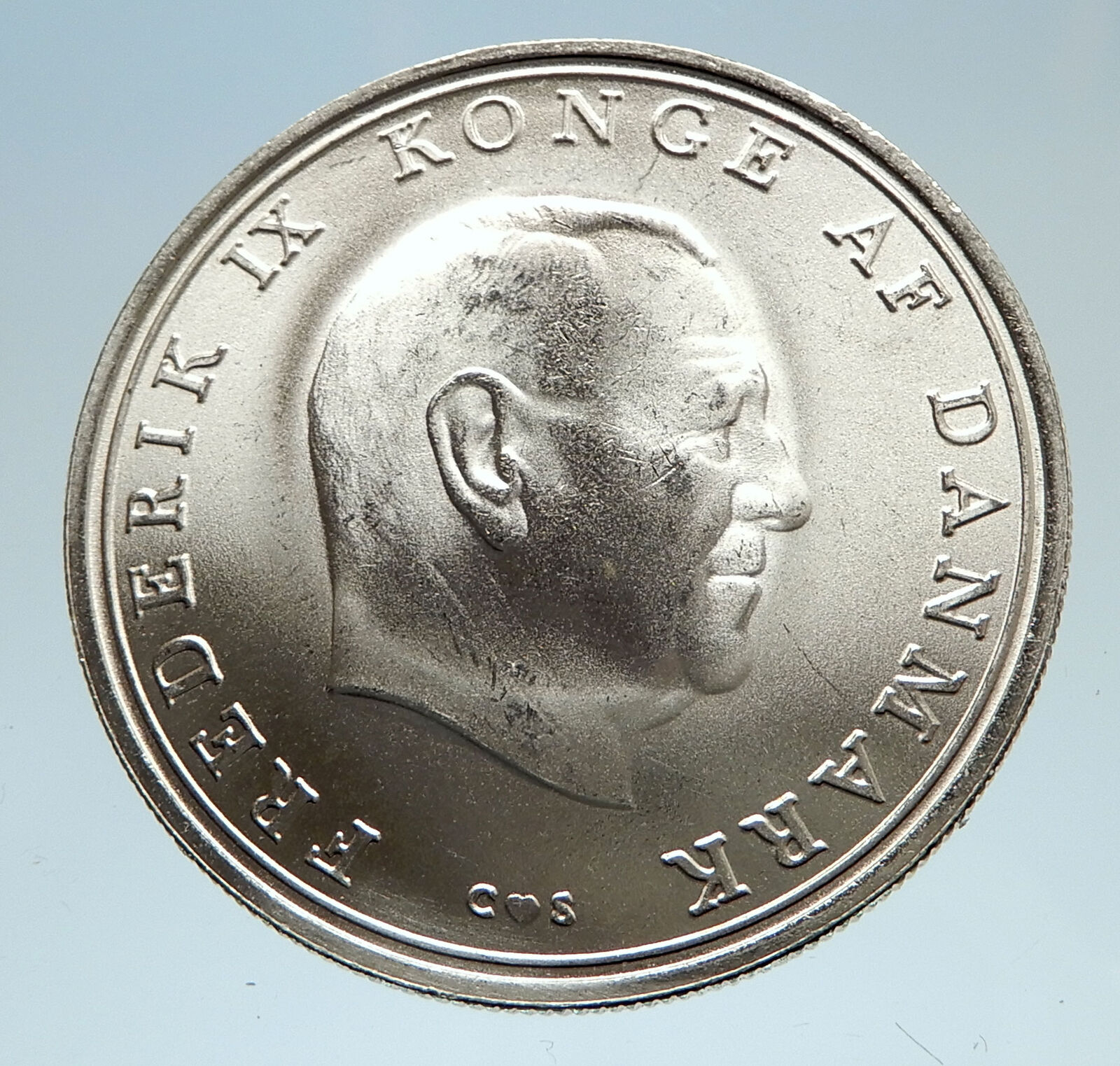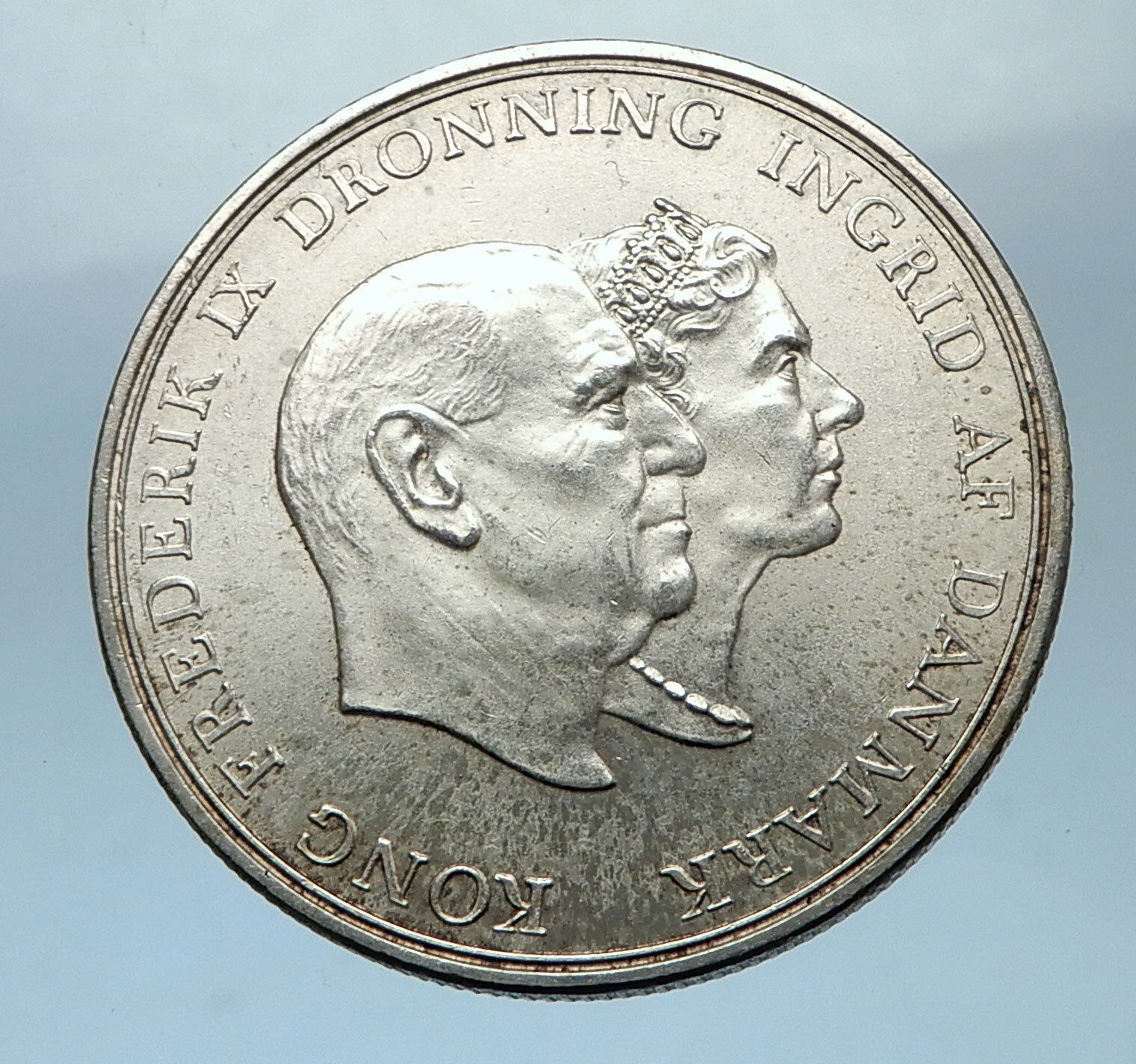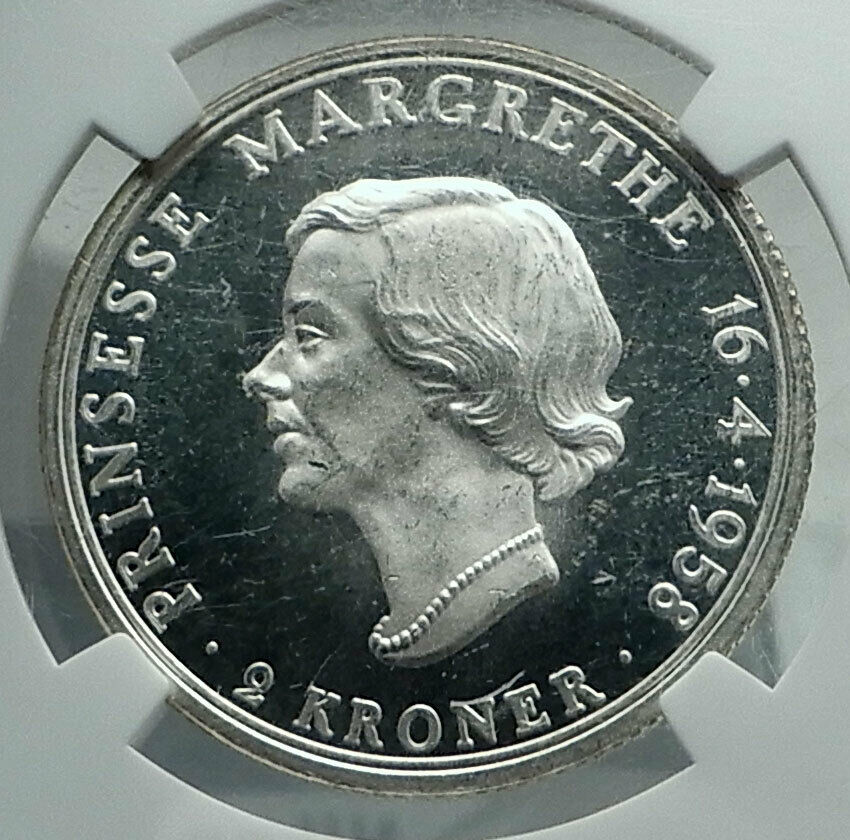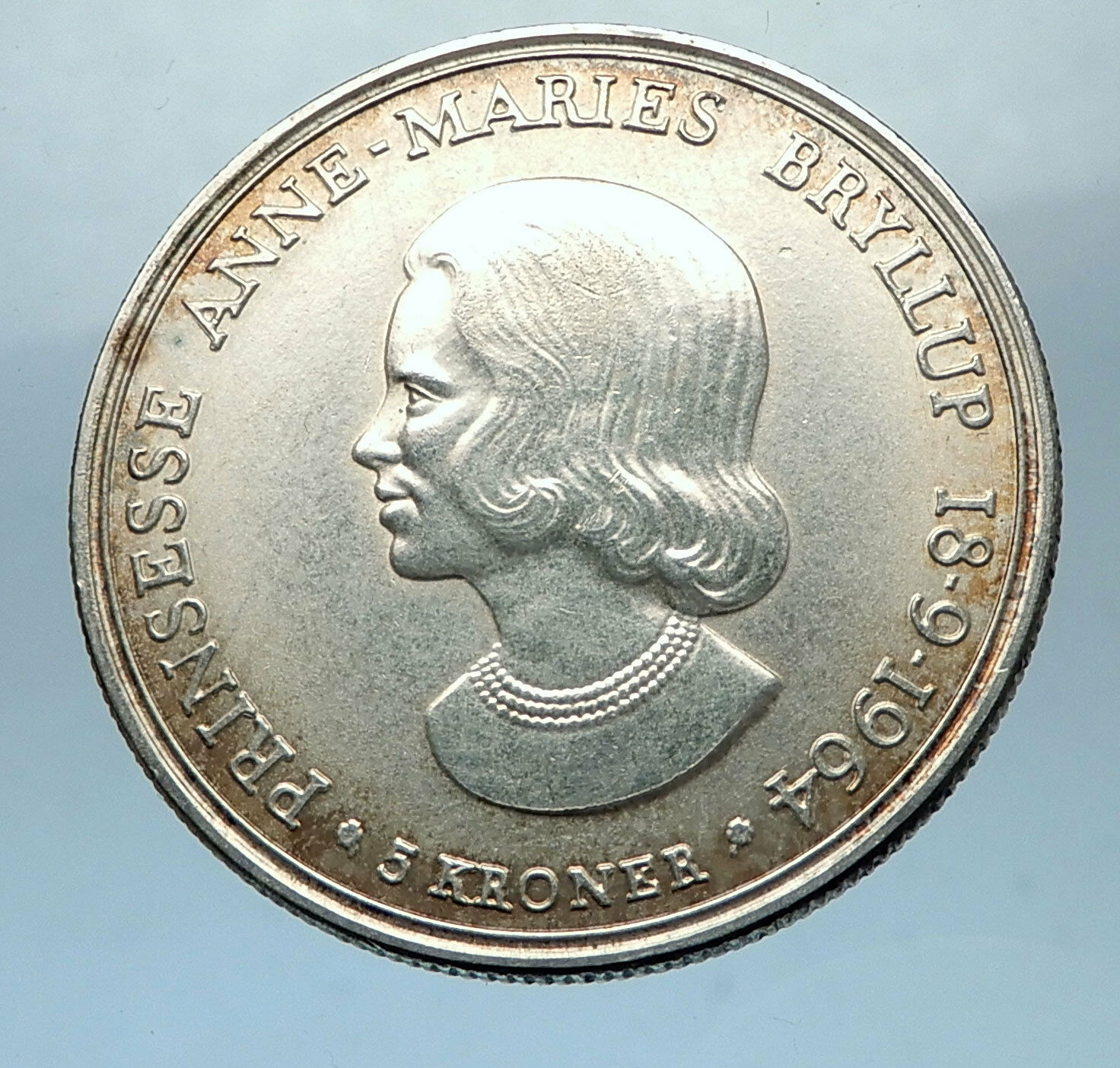|
Denmark under Christian IX – King: November 15, 1863 – January 29, 1906
Death of Christian IX and accession of Frederik VIII
1906 VBP-GJ Silver 2 Kroner 30mm (14.96 grams) 0.800 Silver (0.3858 oz. ASW)
Reference: KM# 803
Certification: NGC
MS 60 2863707-015
CHRISTIAN IX KONGE AF DANMARK 2 KRONER, Christian facing left.
FREDERIK VIII KONGE AF DANMARK HERREN VAERE MIN HIAELPER VBP, Frederick facing left.
You are bidding on the exact item pictured, provided with a Certificate of Authenticity and Lifetime Guarantee of Authenticity.
 Christian IX (8 April 1818 – 29 January 1906) was King of Denmark from 1863 to 1906. From 1863 to 1864, he was concurrently Duke of Schleswig, Holstein and Lauenburg. Christian IX (8 April 1818 – 29 January 1906) was King of Denmark from 1863 to 1906. From 1863 to 1864, he was concurrently Duke of Schleswig, Holstein and Lauenburg.
Growing up as a prince of Schleswig-Holstein-Sonderburg-Glücksburg, a junior branch of the House of Oldenburg which had ruled Denmark since 1448, Christian was originally not in the immediate line of succession to the Danish throne. However, in 1852, Christian was chosen as heir to the Danish monarchy in light of the expected extinction of the senior line of the House of Oldenburg. Upon the death of King Frederick VII of Denmark in 1863, Christian acceded to the throne as the first Danish monarch of the House of Glücksburg.
The beginning of his reign was marked by the Danish defeat in the Second Schleswig War and the subsequent loss of the duchies of Schleswig, Holstein and Lauenburg which made the king immensely unpopular. The following years of his reign were dominated by political disputes as Denmark had only become a constitutional monarchy in 1849 and the balance of power between the sovereign and parliament was still in dispute. In spite of his initial unpopularity and the many years of political strife, where the king was in conflict with large parts of the population, his popularity recovered towards the end of his reign, and he became a national icon due to the length of his reign and the high standards of personal morality with which he was identified.
Christian married his second cousin, Princess Louise of Hesse-Kassel, in 1842. Their six children married into other royal families across Europe, earning him the sobriquet “the father-in-law of Europe”. Most current European monarchs are descended from him, including Queen Margrethe II of Denmark, Queen Elizabeth II of the United Kingdom, King Philippe of Belgium, King Harald V of Norway, King Felipe VI of Spain, and Grand Duke Henri of Luxembourg. The British consort Prince Philip, Duke of Edinburgh is also an agnatic descendant of Christian IX, as are Michael I of Romania and Constantine II of Greece, whose thrones have been abolished. Also, the queens consort Anne of Romania, Anne-Marie of Greece, and Queen Sofia of Spain are among his descendants.
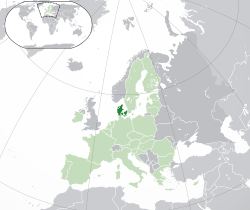
 Denmark is a Scandinavian country in Europe. The southernmost of the Nordic countries, it is southwest of Sweden and south of Norway, and bordered to the south by Germany. The Kingdom of Denmark is a sovereign state that comprises Denmark proper and two autonomous constituent countries in the North Atlantic Ocean: the Faroe Islands and Greenland. Denmark has an area of 42,924 square kilometres (16,573 sq mi), and a population of 5.7 million. The country consists of a peninsula, Jutland, and an archipelago of 443 named islands, of which around 70 are inhabited. The islands are characterised by flat, arable land and sandy coasts, low elevation and a temperate climate. Denmark is a Scandinavian country in Europe. The southernmost of the Nordic countries, it is southwest of Sweden and south of Norway, and bordered to the south by Germany. The Kingdom of Denmark is a sovereign state that comprises Denmark proper and two autonomous constituent countries in the North Atlantic Ocean: the Faroe Islands and Greenland. Denmark has an area of 42,924 square kilometres (16,573 sq mi), and a population of 5.7 million. The country consists of a peninsula, Jutland, and an archipelago of 443 named islands, of which around 70 are inhabited. The islands are characterised by flat, arable land and sandy coasts, low elevation and a temperate climate.
 The unified kingdom of Denmark emerged in the 10th century as a proficient seafaring nation in the struggle for control of the Baltic Sea. Denmark, Sweden and Norway were ruled together under the Kalmar Union, established in 1397 and ending with Swedish secession in 1523. Denmark and Norway remained under the same monarch until the union was dissolved by outside forces in 1814. The deterioration of the Kingdom of Norway, caused by the Black Death, made it possible for Denmark to inherit an expansive colonial empire from this union-of which the Faroe Islands and Greenland are remnants. Beginning in the 17th century, there were several cessions of territory; these culminated in the 1830s with a surge of nationalist movements, which were defeated in the 1864 Second Schleswig War. Denmark remained neutral during World War I. In April 1940, a German invasion saw brief military skirmishes while the Danish resistance movement was active from 1943 until the German surrender in May 1945. An industrialized exporter of agricultural produce in the second half of the 19th century, Denmark introduced social and labour-market reforms in the early 20th century that created the basis for the present welfare state model with a highly developed mixed economy. The unified kingdom of Denmark emerged in the 10th century as a proficient seafaring nation in the struggle for control of the Baltic Sea. Denmark, Sweden and Norway were ruled together under the Kalmar Union, established in 1397 and ending with Swedish secession in 1523. Denmark and Norway remained under the same monarch until the union was dissolved by outside forces in 1814. The deterioration of the Kingdom of Norway, caused by the Black Death, made it possible for Denmark to inherit an expansive colonial empire from this union-of which the Faroe Islands and Greenland are remnants. Beginning in the 17th century, there were several cessions of territory; these culminated in the 1830s with a surge of nationalist movements, which were defeated in the 1864 Second Schleswig War. Denmark remained neutral during World War I. In April 1940, a German invasion saw brief military skirmishes while the Danish resistance movement was active from 1943 until the German surrender in May 1945. An industrialized exporter of agricultural produce in the second half of the 19th century, Denmark introduced social and labour-market reforms in the early 20th century that created the basis for the present welfare state model with a highly developed mixed economy.
The Constitution of Denmark was signed on 5 June 1849, ending the absolute monarchy which had begun in 1660. It establishes a constitutional monarchy-the current monarch is Queen Margrethe II-organised as a parliamentary democracy. The government and national parliament are seated in Copenhagen, the nation’s capital, largest city and main commercial centre. Denmark exercises hegemonic influence in the Danish Realm, devolving powers to handle internal affairs. Denmark became a member of the European Economic Community (now the EU) in 1973, maintaining certain opt-outs; it retains its own currency, the krone. It is among the founding members of NATO, the Nordic Council, the OECD, OSCE, and the United Nations; it is also part of the Schengen Area.
Danes enjoy a high standard of living and the country ranks highly in some metrics of national performance, including education, health care, protection of civil liberties, democratic governance, prosperity and human development. The country ranks as having the world’s highest social mobility, a high level of income equality, is the least corrupt country in the world, has one of the world’s highest per capita incomes, and one of the world’s highest personal income tax rates. A large majority of Danes are members of the Lutheran State Church, though the Constitution guarantees freedom of religion.
|









 Christian IX (8 April 1818 – 29 January 1906) was King of Denmark from 1863 to 1906. From 1863 to 1864, he was concurrently Duke of Schleswig, Holstein and Lauenburg.
Christian IX (8 April 1818 – 29 January 1906) was King of Denmark from 1863 to 1906. From 1863 to 1864, he was concurrently Duke of Schleswig, Holstein and Lauenburg.
 Denmark is a Scandinavian country in Europe. The southernmost of the Nordic countries, it is southwest of Sweden and south of Norway, and bordered to the south by Germany. The Kingdom of Denmark is a sovereign state that comprises Denmark proper and two autonomous constituent countries in the North Atlantic Ocean: the Faroe Islands and Greenland. Denmark has an area of 42,924 square kilometres (16,573 sq mi), and a population of 5.7 million. The country consists of a peninsula, Jutland, and an archipelago of 443 named islands, of which around 70 are inhabited. The islands are characterised by flat, arable land and sandy coasts, low elevation and a temperate climate.
Denmark is a Scandinavian country in Europe. The southernmost of the Nordic countries, it is southwest of Sweden and south of Norway, and bordered to the south by Germany. The Kingdom of Denmark is a sovereign state that comprises Denmark proper and two autonomous constituent countries in the North Atlantic Ocean: the Faroe Islands and Greenland. Denmark has an area of 42,924 square kilometres (16,573 sq mi), and a population of 5.7 million. The country consists of a peninsula, Jutland, and an archipelago of 443 named islands, of which around 70 are inhabited. The islands are characterised by flat, arable land and sandy coasts, low elevation and a temperate climate. The unified kingdom of Denmark emerged in the 10th century as a proficient seafaring nation in the struggle for control of the Baltic Sea. Denmark, Sweden and Norway were ruled together under the Kalmar Union, established in 1397 and ending with Swedish secession in 1523. Denmark and Norway remained under the same monarch until the union was dissolved by outside forces in 1814. The deterioration of the Kingdom of Norway, caused by the Black Death, made it possible for Denmark to inherit an expansive colonial empire from this union-of which the Faroe Islands and Greenland are remnants. Beginning in the 17th century, there were several cessions of territory; these culminated in the 1830s with a surge of nationalist movements, which were defeated in the 1864 Second Schleswig War. Denmark remained neutral during World War I. In April 1940, a German invasion saw brief military skirmishes while the Danish resistance movement was active from 1943 until the German surrender in May 1945. An industrialized exporter of agricultural produce in the second half of the 19th century, Denmark introduced social and labour-market reforms in the early 20th century that created the basis for the present welfare state model with a highly developed mixed economy.
The unified kingdom of Denmark emerged in the 10th century as a proficient seafaring nation in the struggle for control of the Baltic Sea. Denmark, Sweden and Norway were ruled together under the Kalmar Union, established in 1397 and ending with Swedish secession in 1523. Denmark and Norway remained under the same monarch until the union was dissolved by outside forces in 1814. The deterioration of the Kingdom of Norway, caused by the Black Death, made it possible for Denmark to inherit an expansive colonial empire from this union-of which the Faroe Islands and Greenland are remnants. Beginning in the 17th century, there were several cessions of territory; these culminated in the 1830s with a surge of nationalist movements, which were defeated in the 1864 Second Schleswig War. Denmark remained neutral during World War I. In April 1940, a German invasion saw brief military skirmishes while the Danish resistance movement was active from 1943 until the German surrender in May 1945. An industrialized exporter of agricultural produce in the second half of the 19th century, Denmark introduced social and labour-market reforms in the early 20th century that created the basis for the present welfare state model with a highly developed mixed economy.

